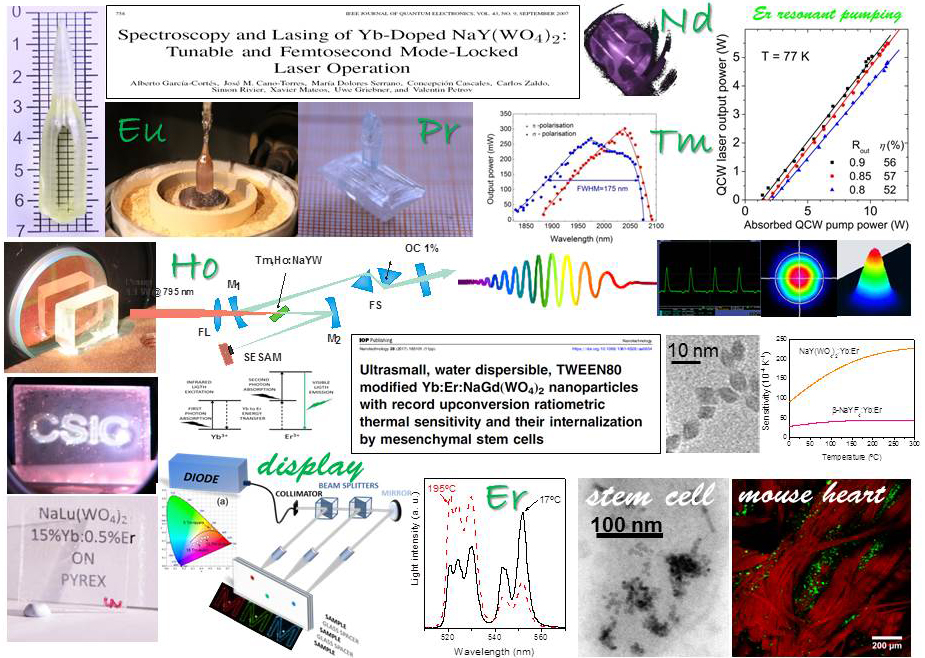
“Non-conventional solutions on luminescence-based high temperature thermometry for applications of industrial interest (IMPETUSS)” Project has been awarded for the period 01/09/2022 to 31/08/2025.
This project proposes new strategies for the design of contactless photoluminescence (PL) thermal probes spanning their operation range to temperatures well above 300 K. These probes will be based either on the PL of lanthanides (Ln) incorporated in inert refractory hosts or on that of carbon quantum dots (CQDs). In combination with remote reading techniques, the new developed thermal probes will enable the creation of bidimensional temperature maps, which may prevent device failures by allowing early detection of thermally aged areas.

“Valorisation of CaNbGa garnets as thin disk elements in high power, high-rate, ultrashort pulsed laser oscillators (THINLAS)” project has been granted for the period 01/12/2022 to 30/11/2024.
This Project aims the extension of thin disk laser (TDL) technology, based on Yb doped YAG single crystals, to modelocked operation by using disordered single crystal Ca3(NbGa)5O12 garnets (CNGG) doped with Yb (or Tm, Ho, and Tm+Ho for emission in the λ≈ 2 µm region), to provide laser pulse durations in the femtosecond (1 fs= 10-15 s) time scale with large pulse peak powers. This is based on the large Yb3+ bandwidth in previously developed CNGG crystals, typically FWHM= 23.5 nm (or 221 cm-1), along with an optical absorption three times more efficient than in YAG, which promises thinner disks with better cooling. The productivity of laser material processing and monitoring in various fields will be greatly improved by a laser module with the characteristics described above. Just to mention some few examples: In photovoltaic silicon cell processing for CO2-free energy harvesting, surface texture free of chemical wastes will be possible. Polymeric soft transparent materials, extensively used in biomedical health care, can be welded and mechanically processed with λ≈ 2 µm laser equipment. LIDAR systems incorporating increased high power lasers and repetition rates will have longer penetration depths and better spatial resolution. Overall, the development of high power–high repletion rate lasers with ultrashort pulse duration will provide new tools for improving the wellness of the population through routes that are compatible with a sustainable and green manufacturing.
The article «Upconverting Nanoparticles in Aqueous Media: Not a Dead-End Road. Avoiding Degradation by Using Hydrophobic Polymer Shells», published in Small, 2021, 2105652, https://onlinelibrary.wiley.com/doi/10.1002/smll.202105652, presents a new strategy to coat and protect β-NaYF4 upconversion nanoparticles (UCNPs) against degradation in aqueous media by growing a hydrophobic polymer shell (HPS) through miniemulsion polymerization of styrene (St), or St and methyl methacrylate mixtures.
Stability studies reveal that these HPSs serve as a very effective barrier, impeding polar molecules to affect UCNPs optical properties. Even more, it allows UCNPs to withstand aggressive conditions such as high dilutions (5 μg mL−1), high phosphate concentrations (100 mm), and high temperatures (70 °C).
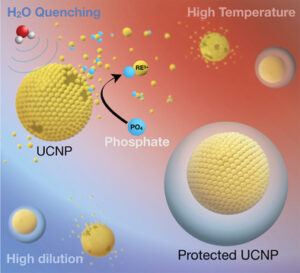
On July 14th 2021 Jorge Omar Álvarez Pérez obtained his PhD degree from the Autonomous University of Madrid with the work entitled «Caracterización física y láser de monocristales de granates desordenados tipo Ca3(NbGa)5O12 dopados con Yb3+» (Physical and laser characterization of Ca3(NbGa)5O12 disordered single crystals doped with Yb3+). The work was awared with the «cum laude» maximum qualificatlon.
The work “A roadmap for laser optimization of Yb:Ca3(NbGa)5O12–CNGG–type single crystal garnet” published in Journal of Materials Chemistry C vol 9, pgs 4628-4642, 2021 https://pubs.rsc.org/en/Content/ArticleLanding/2021/TC/D0TC05718E#!divAbstract
completes a trilogy of new physical knowledge and laser performance progress of this disordered cubic crystal garnet with applications in ultrashort laser pulse oscillators.
Following the path of our original proposal of CNGG Na+ modification for charge compensation of Yb3+ doping, in a first work we introduced a crystallographic model to describe the Yb3+ optical bandwidth. In a second work we disclosed the presence of a small amount of Yb3+ in centrosymmetric octahedral position with dominant magnetic dipole transitions. In the present work we describe how to minimize the crystal coloration, the limits for Na incorporation and the relevant parameters helping for laser performance optimization.
Na and Li codoping of Yb:CNGG is found to provide the broadest tuning range along with best laser preformances.
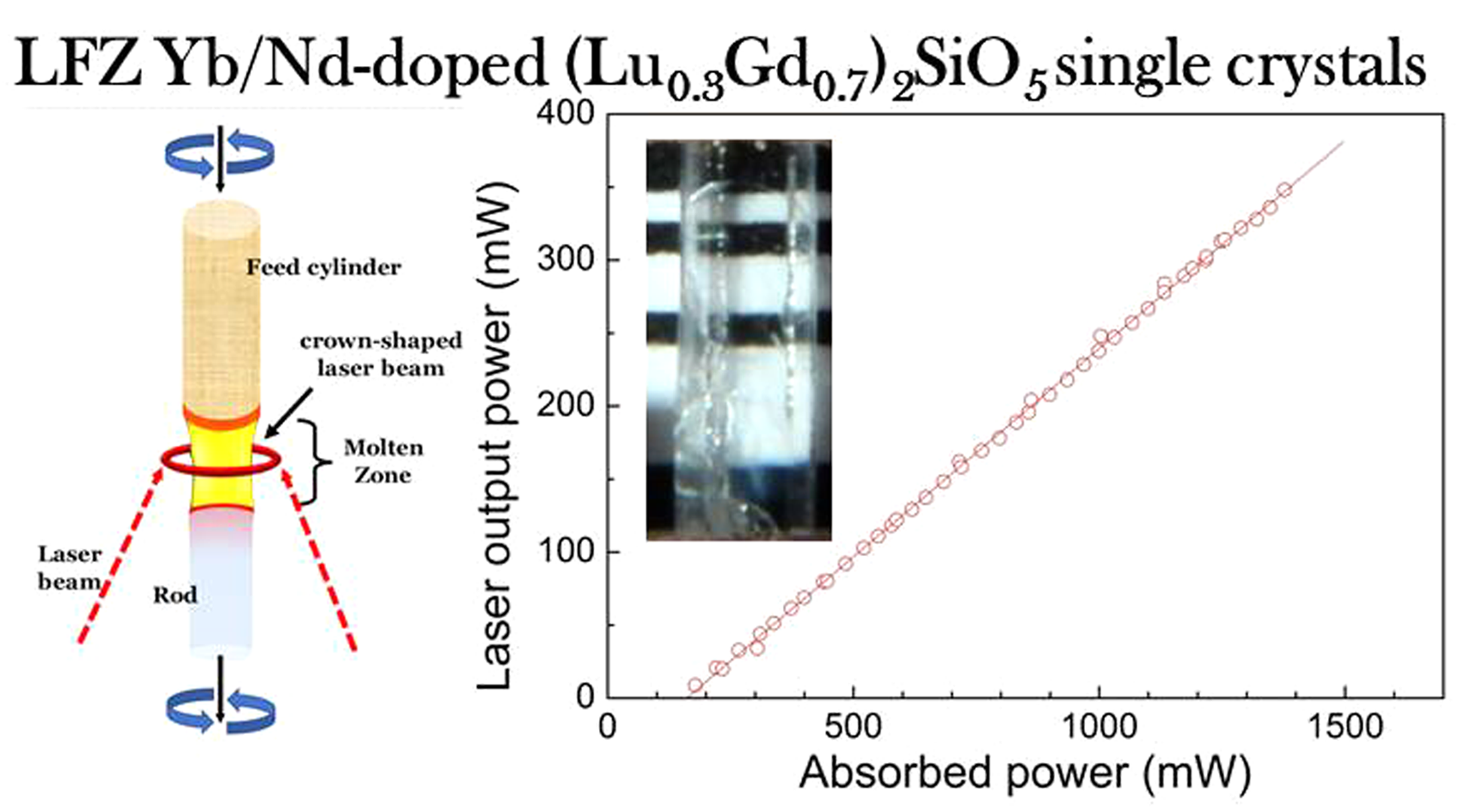 In a recent work published in Journal of Materials Chemistry C 8, 2065, 2020 https://pubs.rsc.org/en/content/articlelanding/2020/tc/c9tc05910e#!divAbstract we show that a laser material with relatively low thermal conductivity can be grown with laser quality by the Laser Floating Zone growth technique using a CO2 laser as heat source for material melting.
In a recent work published in Journal of Materials Chemistry C 8, 2065, 2020 https://pubs.rsc.org/en/content/articlelanding/2020/tc/c9tc05910e#!divAbstract we show that a laser material with relatively low thermal conductivity can be grown with laser quality by the Laser Floating Zone growth technique using a CO2 laser as heat source for material melting.
K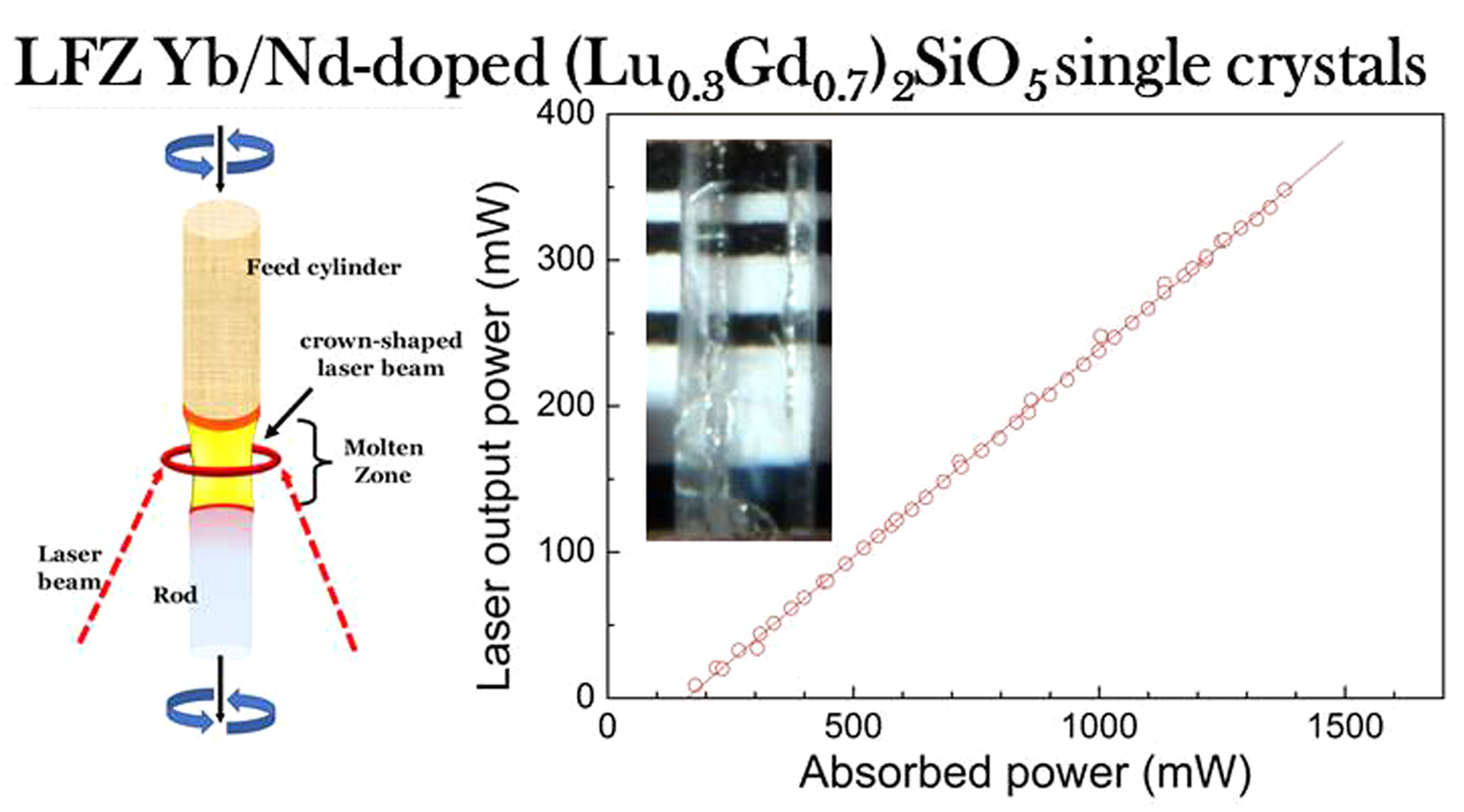 ey steps for this achievement have been the selection of the (Lu0.3Gd0.7)2SiO5 composition to obtain single phase material upon resolidification and the engineering of the heating/cooling cycles.
ey steps for this achievement have been the selection of the (Lu0.3Gd0.7)2SiO5 composition to obtain single phase material upon resolidification and the engineering of the heating/cooling cycles.
The lack of any crucible to hold the material allows the melting of refractory compounds above 1500 ºC in oxidizing atmospheres. This suposses a great advantage for the devellopment of crystals for mode-locked laser producing ultrashort laser pulses.
This has been possible through the collaboration with the Aveiro University.

«Alternative luminescent excitation and material processing paths for brightness and stability optimization of near infrared nanoprobes with biophotonic applications» project has been recently awarded for the period 2019-2021, including economic support of a doctoral position.
Personnel of Pharmacy Faculty of Complutense University-Madrid, Iberian International Nanotechnology Laboratory-Braga, Center of Ultrafast & Ultraintense Pulsed Lasers-Salamanca, and Aveiro University play several different roles in the project activity.
The project aims the development of new luminescent and magnetic nanoprobes and their excitation with commercially available and specifically developed ultrashort (fs) laser pulses and magnetic fields.
Electromagnetic (EM) hyperthermic technologies hold great potential in the treatment of diseases, especially for cancers that are resistant to standard regimens. Hyperthermia is particularly effective in treatment of cervical and breast cancer, head and neck cancers, sarcoma in adults, and germ cell tumours in children; while radiofrequency and microwave ablation offer promise for treating liver, kidney, and lung cancers.
Accurate knowledge of the dielectric and thermal properties of tissues is needed for the development of hyperthermia-based technologies and de-risk the technical challenge before commercialization, However, often researchers working on the development of medical technologies are not fully aware of, and not trained to address the clinical and commercialisation challenges facing novel medical devices.
The MyWAVE Action takes a holistic approach by bringing together key players in the field of dielectric spectroscopy, translational research, and medical professionals. Conjoining these varied communities into one collaborative network is critical to advance the design, development, and commercialisation of EM hyperthermic technologies, so that they can reach patients faster and improve treatment outcomes.
Furthermore MyWAVE also support the training of young scientists as well as scientific conferences in EU countries.
«Lanthanide-based luminescence thermosensors: From bulk to nanoscale«, https://doi.org/10.1016/B978-0-12-813840-3.00010-7 , Chapter 10 in the book entitled «Lanthanide-based multifunctional materials. From OLEDs to SIMs» has been published by ELSEVIER and authored by REALM.
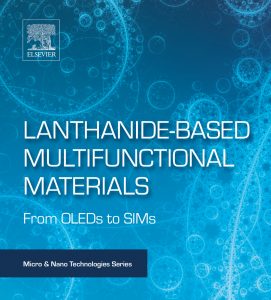
The COST Action CM1403 “The European Upconversion Network: From the Design of Photon-upconverting nanomaterials to Biomedical Applications” was established to support research networks, training of young scientists as well as scientific conferences in countries of the European Union.
More information is available on internet: www.cost.eu/COST_Actions/cmst/CM1403.
REALM group participates in the forthcoming UPCON18 associated conference with the contribution entitled
NaT(XO4)2:Yb:Er NANOPARTICLES WITH RECORD UC THERMAL SENSITIVITY

